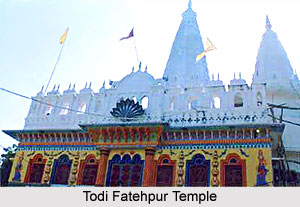 Shri Digambar Jain Chamatkari Kshetra located in Todi Fatehpur in Uttar Pradesh is a Jain pilgrimage centre. It is situated in Jhansi District of Uttar Pradesh. It is an Atishaya Kshetra i.e. Place of Miracles. The principal deity of the temple is Lord Parshvanatha.
Shri Digambar Jain Chamatkari Kshetra located in Todi Fatehpur in Uttar Pradesh is a Jain pilgrimage centre. It is situated in Jhansi District of Uttar Pradesh. It is an Atishaya Kshetra i.e. Place of Miracles. The principal deity of the temple is Lord Parshvanatha.
History of Digambar Jain Chamatkari Kshetra
Digambar Jain Atishaya Chamatkari Kshetra is about 600-700 years old. This temple is known also known as Bada Mandir (Big Temple). According to history once Dharnendra and Padmawati had visited the temple. They made their symbol on a rock. After the incident they visit the temple every month during Krishna Paksha i.e. Fortnight without moon from 12th day to 2nd day of Shukla Paksha i.e. Fortnight with moon.
An interesting is associated with Dharnendra and Padmawati. One day Lord Parshvanatha was going through a forest when he saw a saint busy in Panchagni Tapa. The saint was sitting in the middle while fire sticks were burning around him. Lord Parshvanatha understood that a pair of snakes were burning and told the matter to the saint. He recited `Namokar Mahamantra` to the snakes, due to which they received eternal peace and after death they became Dharnendra and Padmawati in heaven. Later when Parshvanath attained `Keval Gyan` and became Arihant, Dharnendra and Padmawati came here to offer worship and gratitude and to hear the precepts (Divya Dhwani) delivered by Lord Parshvanatha in Samavsharan.
Main Temple of Digambar Jain Chamatkari Kshetra
The temple of Digambar Jain Chamatkari Kshetra is dedicated to Lord Parshvanatha. The idol is said to have miraculous power. The temple is adorned with sky-high pinnacles that have been magnificently constructed. It also has four beautiful ancient altars that have been intricately carved. The first alter houses the idol of Lord Parshvanatha. The idol is very attractive and gorgeous. The other three altars have the images of Bhagwan Rishabh Dev, the first Tirthankara and Lord Padmaprabha, the 6th Tirthankara. Apart from these there are many other temples located here.
The second temple here is Shri Parshvanatha Digambar Jain Temple. The temple has only one altar. In this temple the main deity is Lord Parshvanatha. The Motiwala Chaudhary`s Temple is also located in the vicinity. The Patrai River flows through this kshetra at a small distance. A fort can also be seen near the temple that has a `Golden Kalash` of 50 kg weight. A well with 24 Ghats has been constructed for bathing.
The temple of Digambar Jain Chamatkari Kshetra organises annual gatherings. Every month the Samavsharan Sabha is organized here from 12th day of Krishna Paksha to 2nd day of Shukla paksha. On these days the precepts are delivered on Lord Parshvanath in his Samavsharan. These are heard by audience. Directions are also given to get rid of worldly desires according to Jain tradition and religious acts. Different ways of adopting traditions of forth era (Chaturth Kal) in this modern age of fifth era (Pancham Kal) are also demonstrated. It is compulsory for the devotees visiting the Sabha to wear holy clothes of cotton (khadi). The temple has provisions for dharamshalas or rest houses for the pilgrims.
The temple of Digambar Jain Chamatkari Kshetra is well connected to road, rail and air. Busses are available from Jhansi every day. The nearby Railway Station is `Mauranipur` at 30 km distance. After every 10 minutes busses are available up to `Pandvaha.` Taxies are also available from here. The nearest airport is located from Jhansi at a distance of 100 km.




















